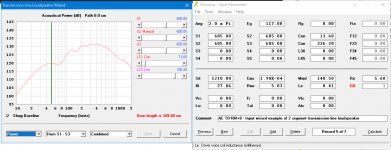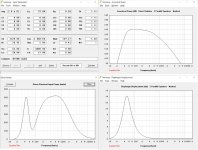If you click around on Instagram enough you can get past that stupid log in screen. I was able to see all the pics without logging in. It may take a few tries and refresh, but it's worth it.I dint use Insta - any other place to view them?/
At least it works on a computer based browser. Don't know about phone.
Given the fact that ALL loudspeaker systems are compromised in one way or another, the closest thing to an ideal loudspeaker system in terms of impedance and efficiency is probably a full length, fully horn loaded system. Once you start undersizing the horns, performance will suffer. In my experience, no other "bass solution" comes even close to the performance of a properly sized (mid) bass horn. The sheer size of these things usually leads to compromises to be made regarding low freq. reproduction.
This comment was posted elsewhere wrt TLs for studio applications:
"Transmission lines, in theory, are a fairly workable idea, with perhaps a better set of compromises than most standard port applications.
The trouble is, that to really do what they ideally should, they need to be fairly significant in scale. This leads to a bit of an issue with practical loudspeaker design. In that the theoretical ideal size of the line, generally makes for a very very large box, like….. huge.
(and so does a sealed box design, to get proper low end you need a massive cabinet)
What happens when you downscale from the ideal, to try and produce a workable near field sized box….. it's not physically possible to fit a "properly" working transmission line, in to such a box.
Thus an ongoing decade old friendly Jibe between myself, and a colleague or two about small PMC's making excellent doorstops…."
Recently, I found out that many of my favorite producers use ATC in their mixing and control rooms. They obviously renounced efficiency in favor of (low impedance) linearity in a modestly sized package.
This comment was posted elsewhere wrt TLs for studio applications:
"Transmission lines, in theory, are a fairly workable idea, with perhaps a better set of compromises than most standard port applications.
The trouble is, that to really do what they ideally should, they need to be fairly significant in scale. This leads to a bit of an issue with practical loudspeaker design. In that the theoretical ideal size of the line, generally makes for a very very large box, like….. huge.
(and so does a sealed box design, to get proper low end you need a massive cabinet)
What happens when you downscale from the ideal, to try and produce a workable near field sized box….. it's not physically possible to fit a "properly" working transmission line, in to such a box.
Thus an ongoing decade old friendly Jibe between myself, and a colleague or two about small PMC's making excellent doorstops…."
Recently, I found out that many of my favorite producers use ATC in their mixing and control rooms. They obviously renounced efficiency in favor of (low impedance) linearity in a modestly sized package.
Last edited:
Last edited:
😀 a lot of people seems to ignore the baffle diffraction and the sound propagation lobes on this site.
Beautiful.
camplo, to honest, in your case I would concentrate on a "flexible" bass solution that's not overly complicated to build. Without a lot of experience a TL would probably require a lot of prototyping and fiddling around with stuffing etc. to get anywhere near a decent solution.
A BR cab is much easier to build and tweak (afterwards). In the end, you could either stuff the ports and/or add a high pass to optimize in room response.
Ultimately, there are only 2 enclosure types that allow swapping drivers (of different brands) without requiring major modifications and / or resulting in severely compromised performance: sealed and bass reflex.
Just my €0.02 😉
A BR cab is much easier to build and tweak (afterwards). In the end, you could either stuff the ports and/or add a high pass to optimize in room response.
Ultimately, there are only 2 enclosure types that allow swapping drivers (of different brands) without requiring major modifications and / or resulting in severely compromised performance: sealed and bass reflex.
Just my €0.02 😉
Last edited:
Maybe you want to trade Horn Resp formulas? I am only going by what I can come up with in Hornresp. I configurate until I get a response that I like....it was seeming that I could fit a TL in a 10cuft space for the 18"...The TL construction solves a lot of enclosure issues, hard to not want it. A slightly smaller TL for the 15" tuned to the crossover at 100hz?
Did you try to sim a br cab in horresp? I haven't yet.
10 cu ft would be just about acceptable 😉
Horn resp. (input) for TD15M-8 and TD18H+ :
10 cu ft would be just about acceptable 😉
Horn resp. (input) for TD15M-8 and TD18H+ :
Attachments
Last edited:
I have done this already yes! I've talked to some people on a forum dedicated to TL building, a person told me his technique, it is a process, but eventually you'll get it right. Mainly the application of the filling, is what I'm talking about, and from what I've read, a TL is forgiving to thiele specs. I wonna try it, if size permits.
😀 a lot of people seems to ignore the baffle diffraction and the sound propagation lobes on this site.
Beautiful.
Are you referring to the "flower in a pot" designs?
I have done this already yes! I've talked to some people on a forum dedicated to TL building, a person told me his technique, it is a process, but eventually you'll get it right. Mainly the application of the filling, is what I'm talking about, and from what I've read, a TL is forgiving to thiele specs. I wonna try it, if size permits.
If you can rely on an experienced "big brother" during the design and construction phase, it might save you lots of time and hassle.
Don't get me wrong, the end result may well be worth the extra effort.
Last edited:
So, I think, if I were to take this, fold it, the resonance moves around to different areas...Then its your job to fold it in a way that doesn't compound resonant notes and are close as possible to the tuning note, once partially assembled you would measure it and fill accordingly until desired affect.
There is a folded TL calculator but it doesn't model Fr.
GM I thought this was your area.
There is a folded TL calculator but it doesn't model Fr.
GM I thought this was your area.
Attachments
If you'd rather spend money on drivers than cabinetry, you could use two TD18s per side in simple sealed cabinets With a little EQ you get this response at the excursion and power limits:
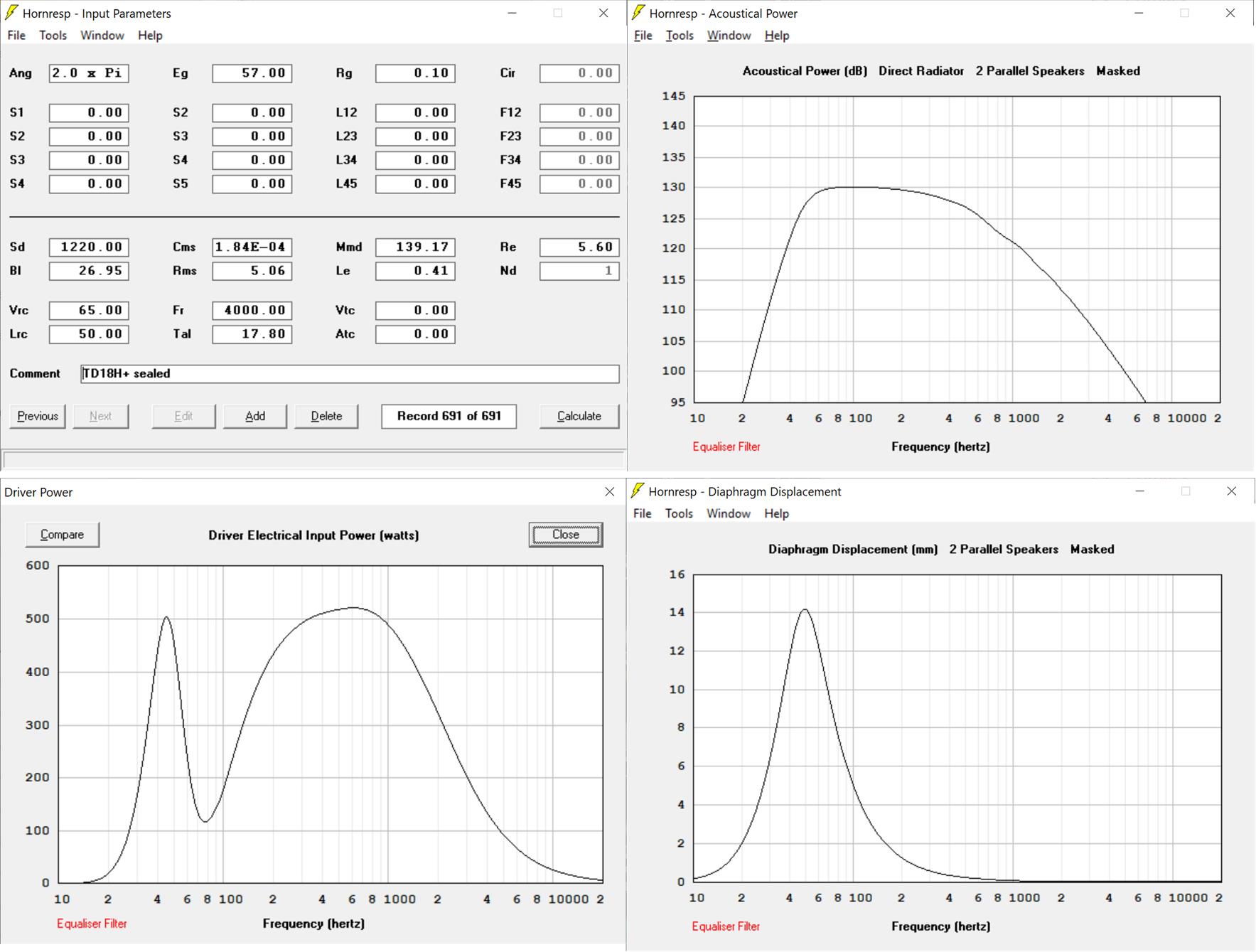
Two 18's side by side would be a fair match for the horns you are looking at. At in home levels, you can use more Linkwitz transform boost and not need subs
Two 18's side by side would be a fair match for the horns you are looking at. At in home levels, you can use more Linkwitz transform boost and not need subs
Attachments
A short follow-up on my impressions of the Danley Pure Groove SH96HO and SH50.
It just occurred to me that a hornloaded system tuned for flat response at full output tends to sound thin at low levels.
On both occasions, the Danleys were played way below the usual average SPL in these respective venues, i.e. no earplugs required.
The Jericho 1s, installed and tuned by the same company, definitely didn't suffer from a lack of body in the midrange, at none of about 20 occasions I've heard these in action (at high SPL).
It just occurred to me that a hornloaded system tuned for flat response at full output tends to sound thin at low levels.
On both occasions, the Danleys were played way below the usual average SPL in these respective venues, i.e. no earplugs required.
The Jericho 1s, installed and tuned by the same company, definitely didn't suffer from a lack of body in the midrange, at none of about 20 occasions I've heard these in action (at high SPL).
Last edited:
Does anyone know of any tricks to improve mid range? I was reading about a style where the driver would be basically in a tube that ran to the back end of the sealed enclosure and opened up, into the rest of the cavity filled with filler. Thats doable.
It just occurred to me that a hornloaded system tuned for flat response at full output tends to sound thin at low levels.
Look at the equal loudness curves, it's your ears, not the speakers.
That said, a constant directivity system should not be balanced flat indoors.
Evidently, I am aware of "my ears" 😉
There's more to it, especially with 4-point installs. I may elaborate on this later.
Another major factor to be taken into account is the quality of the source material being played.
There's more to it, especially with 4-point installs. I may elaborate on this later.
Another major factor to be taken into account is the quality of the source material being played.
Last edited:
The following is a little OT, but probably interesting enough to warrant a few posts.
Tom Danley:
“By setting as my standard of reproduction the accurate transformation of an electical impluse into an acoustical impulse, I favor one over the other. I favor a system that maximizes the reproduction of the sound engineered into the recording. Even with this as my reference, however, room effects (and power response) are still important. You do not want directional lobing or large peaks in the off-axis or power response of a system. You do not want large peaks in the on-axis and or anachoic response of a system.
In a larger room, larger audience all the problems are more severe making all these issues even more critical if one is to understand words, voices music etc."
Here's a comment by John Sheerin on the GOTO full horn system that Pano got to listen to at Capital Audio Fest 2010:
"I got it to the point where I thought it was subjectively flat in-room based on outside measurements, but the problem with that is that if you don't play music at realistic levels it will then always sound thin."
Conclusion: the room matters, but the (in-room) "conditions" matter too.
Tom Danley:
“By setting as my standard of reproduction the accurate transformation of an electical impluse into an acoustical impulse, I favor one over the other. I favor a system that maximizes the reproduction of the sound engineered into the recording. Even with this as my reference, however, room effects (and power response) are still important. You do not want directional lobing or large peaks in the off-axis or power response of a system. You do not want large peaks in the on-axis and or anachoic response of a system.
In a larger room, larger audience all the problems are more severe making all these issues even more critical if one is to understand words, voices music etc."
Here's a comment by John Sheerin on the GOTO full horn system that Pano got to listen to at Capital Audio Fest 2010:
"I got it to the point where I thought it was subjectively flat in-room based on outside measurements, but the problem with that is that if you don't play music at realistic levels it will then always sound thin."
Conclusion: the room matters, but the (in-room) "conditions" matter too.
Last edited:
4 point speaker configurations in clubs
Taken from a Pro forum:
"While visiting some nightclubs around Europe I noticed that many of them (Berghain in Berlin, for example, with their Funktion-One system) arranged their speaker stacks around the dance floor aimed inward rather than having them all in a row facing in one direction. On paper this strikes me as a bad idea due to phase issues, but it sounded amazing in most cases and they were able to keep the sound levels a bit lower and still fill the space very well, though some were really loud too."
Ian Beaver (Danley Soundlabs):
"In smaller spaces it can work. But in larger spaces it really starts to screw with the sound-due to the longer arrivals. The whole idea is to "surround yourself with music". Which sounds good-until you realize how slow sound moves. In a larger space the sound gets really smeared and starts to sound like echoes-depending on where you listening from. In the middle it can be good and quite cool, but off to any side or front or rear it starts to get really messed up.
So it depends on where the priority is. Of course loudspeaker manufacturers LOVE the idea and like to push it. This is because they will sell more loudspeakers for a given job. But when they do that-they are basically saying they don't care about sound quality-at least in terms of accuracy to what the artist is doing."
Randy Pence (experienced Sound Engineer, Germany):
"For typical nightclubs, I disagree. There is more to the experience than simply being enveloped by the sound. From the get-go, the djs play the source tracks at different speeds and pitches than the producers released them, and will blend the intros, outros and whatever else with other tracks. The inherent distortion of vinyl is still seen as superior to the source files.
A club like Berghain is a far cry from the more commercial experiences where the visual focus is only around some dj on a stage surrounded by video walls and whatever else. There, the dj is not visually focused on as much, the audience looks and dances in every direction and everyone would rather be in more of the direct than reverberant field. Since sound is always a series of compromises, for this kind of experiences, absolute phase accuracy is sacrificed by evening out the pressure around the dancefloor. These kinds of spaces rarely have ceilings high enough to fly speakers in a manner which truly allows a minimum inverse sq loss across the dancefloor from just a stereo hang.
For a real world example, I did a demo with 4 Danley Sound Labs SH-46s far, far below their acoustic limits for a dancefloor quite simialr in size to what the OP is interested in. We first arrayed the speakers from 2 points. Across the dancefloor was a wall which of course reflected the sound. The roduction company I did the demo with said that they would create something of a virtual surround system. The potential customer heard it and immediately asked about splitting the tops because the volume levels were not even when walking the floor. Upon doing so, the overall experience improved significantly, even when the horns were not really aimed properly due to rigging restraints.
From my salad days at Twilo in NYC to now, properly designing 4-point+ systems for dj oriented dancefloors has been part science, part art, part luck of what the venue offers. Start off with what area needs to be covered. It is probably rectangular in shape, so something close to 360 degrees of horizontal coverage will be necessary. Orient 4 points of sound in the corners of the dancefloor, get the mid-high horns around at least 3m off the ground and aim them at the center of the dancefloor, taking care to cover the near-field areas closest to the speakers, too. Berghain fails at this - the mid-high horns are too high off the ground for their given vertical coverage and the closer to the stacks one is, the more likely they are going to get that frequency content from across the floor.
Something Ivan has often gone on about regarding how to measure speakers, is that too close to a speaker, the box itself impacts the real-world accuracy of the measurements when speaking of longer frequency wavelengths. I've not had the chance to measure this myself in smaller rooms, but I have a feeling something similar is going on which makes additional points of sound more useful with respect to 80-200hz. Danley subs (granted, a lower frequency range), for example, are measured 10 meters away, but most nightclub dancefloors are not measured in the tens of meters. Berghains dancefloor is only roughly 15m x 15m, and the OP might have noticed that there are 2 flown arrays, which sorta fill in zones which have too noticeable pressure zones from the rest of the areas much closer to the groundstacks. I have a feeling that they could have simply flown the mid-high sections from the stacks a bit higher and forming more of a square than rectangle and the additional arrays would not be "necessary." The flown sections were added many years after opening.
So let's say that side-fills do help for maintaining pressure around the dancefloor, now what? Add delay and turn them down until highs sound like they come from the outer corners. How wide of coverage should the sidefills have? Depends on the coverage of the corners and room itself. One space I did, had tops available which had around 70 degrees of horizontal coverage per speaker, often dipping below that. The main dancefloor area was about 9m x 6m and then midway between the ends and about 5m from the dancefloor I added fills. This system was ranked only behind Berghain for some 2005 local Berlin magazine poll."
And:
"For 4+ systems, I generally have also split the subs. There is the truth that the subs interact negatively with the increased sources, but rooms themselves do what they want with cancellations as the waves bounce around. Splitting the subs allows more of the kickdrums to align with the portion sent to the tops. For better or worse, dance music dancefloor experience is centered around that pulsing kick, something you experienced at berghain for sure. There is a local company here which will stack their subs in some point which pressurizes the room more evenly, but do not really line up with the tops.
For the latest project I've been involved in, we flew one monster sub (Danley Sound Labs BC-415) and 4 tops (Danley PG-96) for a 12m x 15m dancefloor and think that experience could unseat Berghain when the place finally opens.
For one venue I spent a long time in, I had 8x single 18" reflex subs and tried everything from even splits to one cluster in different formations and what worked best was to stack two of them in 2 corners and run 4 in a line along the middle of the opposing wall. It just depends."
Taken from a Pro forum:
"While visiting some nightclubs around Europe I noticed that many of them (Berghain in Berlin, for example, with their Funktion-One system) arranged their speaker stacks around the dance floor aimed inward rather than having them all in a row facing in one direction. On paper this strikes me as a bad idea due to phase issues, but it sounded amazing in most cases and they were able to keep the sound levels a bit lower and still fill the space very well, though some were really loud too."
Ian Beaver (Danley Soundlabs):
"In smaller spaces it can work. But in larger spaces it really starts to screw with the sound-due to the longer arrivals. The whole idea is to "surround yourself with music". Which sounds good-until you realize how slow sound moves. In a larger space the sound gets really smeared and starts to sound like echoes-depending on where you listening from. In the middle it can be good and quite cool, but off to any side or front or rear it starts to get really messed up.
So it depends on where the priority is. Of course loudspeaker manufacturers LOVE the idea and like to push it. This is because they will sell more loudspeakers for a given job. But when they do that-they are basically saying they don't care about sound quality-at least in terms of accuracy to what the artist is doing."
Randy Pence (experienced Sound Engineer, Germany):
"For typical nightclubs, I disagree. There is more to the experience than simply being enveloped by the sound. From the get-go, the djs play the source tracks at different speeds and pitches than the producers released them, and will blend the intros, outros and whatever else with other tracks. The inherent distortion of vinyl is still seen as superior to the source files.
A club like Berghain is a far cry from the more commercial experiences where the visual focus is only around some dj on a stage surrounded by video walls and whatever else. There, the dj is not visually focused on as much, the audience looks and dances in every direction and everyone would rather be in more of the direct than reverberant field. Since sound is always a series of compromises, for this kind of experiences, absolute phase accuracy is sacrificed by evening out the pressure around the dancefloor. These kinds of spaces rarely have ceilings high enough to fly speakers in a manner which truly allows a minimum inverse sq loss across the dancefloor from just a stereo hang.
For a real world example, I did a demo with 4 Danley Sound Labs SH-46s far, far below their acoustic limits for a dancefloor quite simialr in size to what the OP is interested in. We first arrayed the speakers from 2 points. Across the dancefloor was a wall which of course reflected the sound. The roduction company I did the demo with said that they would create something of a virtual surround system. The potential customer heard it and immediately asked about splitting the tops because the volume levels were not even when walking the floor. Upon doing so, the overall experience improved significantly, even when the horns were not really aimed properly due to rigging restraints.
From my salad days at Twilo in NYC to now, properly designing 4-point+ systems for dj oriented dancefloors has been part science, part art, part luck of what the venue offers. Start off with what area needs to be covered. It is probably rectangular in shape, so something close to 360 degrees of horizontal coverage will be necessary. Orient 4 points of sound in the corners of the dancefloor, get the mid-high horns around at least 3m off the ground and aim them at the center of the dancefloor, taking care to cover the near-field areas closest to the speakers, too. Berghain fails at this - the mid-high horns are too high off the ground for their given vertical coverage and the closer to the stacks one is, the more likely they are going to get that frequency content from across the floor.
Something Ivan has often gone on about regarding how to measure speakers, is that too close to a speaker, the box itself impacts the real-world accuracy of the measurements when speaking of longer frequency wavelengths. I've not had the chance to measure this myself in smaller rooms, but I have a feeling something similar is going on which makes additional points of sound more useful with respect to 80-200hz. Danley subs (granted, a lower frequency range), for example, are measured 10 meters away, but most nightclub dancefloors are not measured in the tens of meters. Berghains dancefloor is only roughly 15m x 15m, and the OP might have noticed that there are 2 flown arrays, which sorta fill in zones which have too noticeable pressure zones from the rest of the areas much closer to the groundstacks. I have a feeling that they could have simply flown the mid-high sections from the stacks a bit higher and forming more of a square than rectangle and the additional arrays would not be "necessary." The flown sections were added many years after opening.
So let's say that side-fills do help for maintaining pressure around the dancefloor, now what? Add delay and turn them down until highs sound like they come from the outer corners. How wide of coverage should the sidefills have? Depends on the coverage of the corners and room itself. One space I did, had tops available which had around 70 degrees of horizontal coverage per speaker, often dipping below that. The main dancefloor area was about 9m x 6m and then midway between the ends and about 5m from the dancefloor I added fills. This system was ranked only behind Berghain for some 2005 local Berlin magazine poll."
And:
"For 4+ systems, I generally have also split the subs. There is the truth that the subs interact negatively with the increased sources, but rooms themselves do what they want with cancellations as the waves bounce around. Splitting the subs allows more of the kickdrums to align with the portion sent to the tops. For better or worse, dance music dancefloor experience is centered around that pulsing kick, something you experienced at berghain for sure. There is a local company here which will stack their subs in some point which pressurizes the room more evenly, but do not really line up with the tops.
For the latest project I've been involved in, we flew one monster sub (Danley Sound Labs BC-415) and 4 tops (Danley PG-96) for a 12m x 15m dancefloor and think that experience could unseat Berghain when the place finally opens.
For one venue I spent a long time in, I had 8x single 18" reflex subs and tried everything from even splits to one cluster in different formations and what worked best was to stack two of them in 2 corners and run 4 in a line along the middle of the opposing wall. It just depends."
Last edited:
This is what the Berghain's dancefloor looked like when I first visted it in 2006:
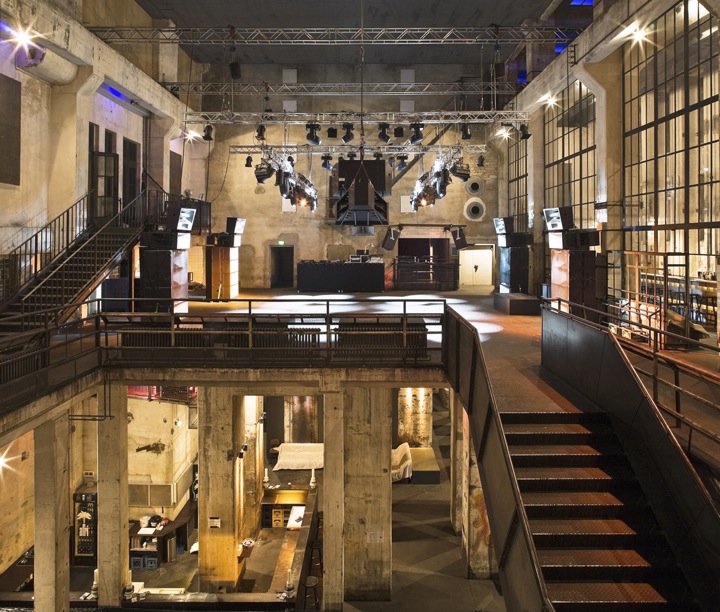
Years (and many in-between visits) later I entered the club unusually early, around 11 p.m. The F1 system had just undergone it's first major upgrade, including the flown infills, visible in the image below.
The DJ - I appreciate for his attention to sound quality, had just started his set at very low SPL. Given the fact the F1 system is hardly ever operated above 20% of it's full capacity, it was merely "idling" at that moment.
Almost a decade later, that moment is still my reference as regards to clubsound. Heck, I've listened to hi-fi systems costing up to €1 million that sounded laughable in comparison. I have to admit, it's the only time of >25 visits to the club I had that particular experience.
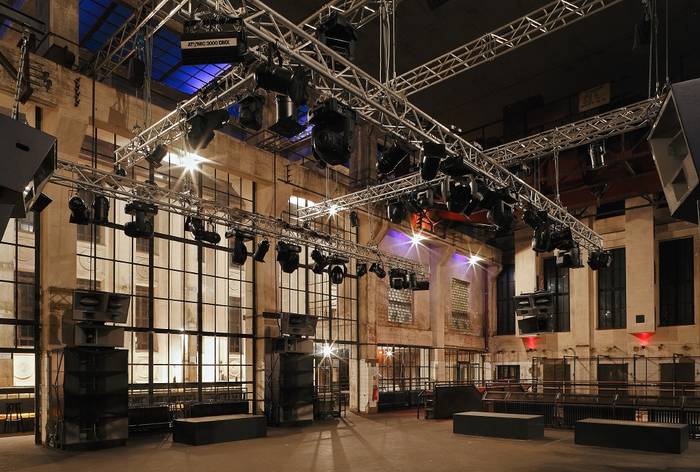
Back to 2-ways 😉

Years (and many in-between visits) later I entered the club unusually early, around 11 p.m. The F1 system had just undergone it's first major upgrade, including the flown infills, visible in the image below.
The DJ - I appreciate for his attention to sound quality, had just started his set at very low SPL. Given the fact the F1 system is hardly ever operated above 20% of it's full capacity, it was merely "idling" at that moment.
Almost a decade later, that moment is still my reference as regards to clubsound. Heck, I've listened to hi-fi systems costing up to €1 million that sounded laughable in comparison. I have to admit, it's the only time of >25 visits to the club I had that particular experience.

Back to 2-ways 😉
Last edited:
Maybe these horns would become too big for camplo with respect to mouth size but I like the new possibilities by using different progressive expansion expressions for horizontal and vertical profiles (HVdiff):
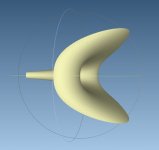
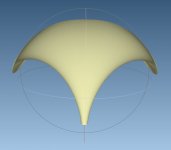
View attachment drba_jmlc250_hvdiff_rb180.zip
These shapes have an underlying super ellipse exponent of 2.5.


View attachment drba_jmlc250_hvdiff_rb180.zip
These shapes have an underlying super ellipse exponent of 2.5.
- Home
- Loudspeakers
- Multi-Way
- Is it possible to cover the whole spectrum, high SPL, low distortion with a 2-way?
